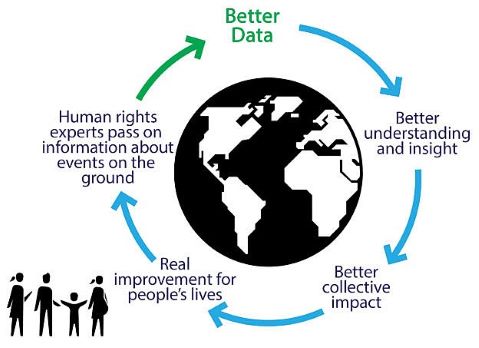Methodology
How do we measure countries’ human rights performance?
Economic and social rights | Civil and political rights | Private sector dataset
What gets measured, gets improved.
The Human Rights Measurement Initiative (HRMI) works to provide robust, comprehensive measurements to track the human rights performance of countries.
We are working towards measuring all human rights contained in international treaties and other important documents. To begin with, we have developed two different measurement methodologies for two key sets of rights: economic and social rights and civil and political rights.
Our measurements of these rights are published on the Rights Tracker.
Our methodologies are distinctive in four ways:
We use co-design
Co-design is HRMI’s foundation methodology and we continually use it to develop our methodologies. We invite a wide range of people to contribute their concerns, ideas, and experience to the design process. Crucially, our methodologies are shaped by both human rights defenders, and human rights measurement academics.
This ensures the work is shaped by the needs of the human rights communities we walk alongside. It also ensures that those traditionally excluded from data conversations have the decision-making power to shape the measurement practice, process, and outcomes, and are meaningfully heard, right from the beginning. This also helps to shift power away from Western, white perspectives and people, which is an ongoing process we are committed to.
Ultimately, this leads to robust methodologies that are widely accepted both in the human rights practitioner community, and among scholars.
We work with professional Co-Design facilitator teams such as Co-Creative to best achieve this.
Co-design is resource intensive, but collaboration is one of our core values and the only way truly collaborative human rights measurement can take place is working together right from the beginning.
We measure human rights as expressed in international law
Many useful monitoring and measuring tools shine a light on different parts of social and government behaviour.
Our unique contribution is to focus on the human rights obligations of countries, and measure how well they are meeting them. We use the rights definitions contained in international human rights treaties and related documents that have been agreed upon by all signatory countries.
We measure economic and social rights as laid out in the International Covenant on Economic, Social, and Cultural Rights, and civil and political rights as laid out in the International Covenant on Civil and Political Rights. We also refer to related treaties such as the Convention on Torture, and General Comments of treaty bodies.
We produce numbers
Our measurements are in clear numbers, so it’s easy to see progress and deterioration over time. Our methodologies provide scores that are comparable between countries, and over time. These comparisons are available on the Rights Tracker.
We are independent and non-profit
Many diplomatic and government bodies find it difficult to speak clearly about the human rights situation in a country.
We are entirely independent of all governments; and we are a non-profit research collective. Our only motivation is to produce useful, robust measurement tools that others can use in their work to improve people’s lives.
Our data are freely available on the Rights Tracker. The data are published annually on the Rights Tracker, and the dataset is available to download.
All content is licensed under a Creative Commons Attribution Non-Commercial 4.0 International License. This means that you are free to use the data (with attribution to HRMI) for any non-commercial or journalistic purpose. If you would like to use the data for commercial purposes, please contact our partner organisation Rights Intelligence.
Measuring economic and social human rights
Our five economic and social human rights metrics are constructed from internationally comparable, publicly available, objective data, such as statistics on infant mortality and school enrolment. Our metrics show how each country is doing – on each of the five rights – relative to what is feasible for a country with that level of economic resources.
Economic and social human rights ensure that all people have access to the basic goods, services, and opportunities necessary to survive and thrive.
In international law, they can be summed up as discrimination-free access to an adequate standard of living, dignified employment, a minimum basic income, comprehensive health care, and extensive educational and cultural opportunities.
With a strong presence in the Universal Declaration and the core international human rights treaties, economic and social rights are equal in status and importance with civil and political rights.
What is unique about these measures compared with other indicators of economic development?
Our measures are based on a methodology that is unique in this area. It allows us to show how well the country is using its available resources to ensure all people enjoy these rights. We do this because under international law, a higher level of performance is expected from richer countries.
The Human Rights Measurement Initiative’s (HRMI’s) economic and social rights fulfilment measures are the only measures that:
- Show how well each country is doing relative to what is feasible for a country with that level of economic resources.
- Allow cross-country comparisons in rights fulfilment.
- Provide an objective assessment of whether the overall situation regarding each economic and social right in a country is improving or deteriorating.
- Provide a methodology to examine disparity in rights fulfilment between regions, or between racial, ethnic, gender, and other population sub-groups.
Our measures of economic and social rights
At this time, HRMI’s economic and social rights measures capture the fulfilment of five economic and social human rights:
- Right to education
- Right to food
- Right to health
- Right to housing
- Right to work

Each of these is constructed from internationally-comparable, publicly-available objective data, such as statistics on infant mortality and school enrolment. They also take into account the fact that, as stated in Article 2 of the International Covenant on Economic, Social, and Cultural Rights (ICESCR), each country is obligated to progressively achieve economic and social rights “to the maximum of its available resources.” Essentially, this means that better performance is expected from richer countries.
Statistics such as school enrolment and infant mortality can help to tell us the extent to which individuals in each country enjoy economic and social rights. But it is not until the country’s GDP per capita is also taken into account that we can get a good sense of whether a state is complying with its obligations to progressively respect, protect, and fulfil those rights. These measures do just that.
This methodology, the Social and Economic Rights Fulfilment (SERF) Index, has been developed by Sakiko Fukuda-Parr, Terra Lawson-Remer, and Susan Randolph at the University of Connecticut. This approach is highly regarded by the human rights community. In 2016, a book detailing this methodology – Fulfilling Social and Economic Rights by Sakiko Fukuda-Parr, Terra Lawson-Remer, and Susan Randolph – won the American Political Science Association prize for the best book in human rights scholarship, and in 2019, the three authors were awarded the prestigious Grawemeyer Award for Ideas Improving World Order.
For more information you might like to watch Susan Randolph’s TED talk on measuring economic and social rights or read our detailed methodology handbook.
What data are available, for what years, and where can I find the data?
Measures for these five rights have been calculated for around 200 countries, depending on the right, going back 10 years. You can access them on our Rights Tracker website. The SERF Index Project also publishes these social and economic rights data on its website.
Using our calculator
We have developed a calculator tool so users can find scores that use our methodology for other sets of data using the same indicators.
For example, if you have access to data on a particular ethnic group’s rates of stunting or primary school enrolment, you can use the calculator to produce a score that you can compare with the country score we produce.
We would appreciate your feedback.
Population statistics
How many people would benefit if a country lifted its performance?
When a country is not meeting its obligations, and is scoring lower than 100% for a right, there will be a certain number of people who are missing out, whose lives would be improved if their country lifted its score.
Anyone can calculate these figures using population data, and the information on the Rights Tracker. We are seeking funding to be able to provide these calculations on the Rights Tracker for every country.
In the meantime, we have begun to provide these population statistics for some countries, such as India, in our Country Spotlights.
References
Fukuda-Parr, Sakiko, Terra Lawson-Remer and Susan Randolph. 2015. Fulfilling Social and Economic Rights. Oxford University Press.
Measuring civil and political human rights
- Right to Freedom from Arbitrary Arrest
- Right to Freedom from Disappearance
- Right to Freedom from the Death Penalty
- Right to Freedom from Extrajudicial Execution
- Right to Freedom from Torture
- Right to Assembly and Association
- Right to Opinion and Expression
- Right to Participate in Government
- Right to Freedom of Religion and Belief

Why measuring civil and political human rights is difficult
Our solution to these challenges

Which countries do we measure civil and political rights in?
Who can be a survey respondent?
Measuring human rights for private sector use
To learn more about these products, check out the Rights Intelligence website and find out how the first product to market is created: the Rights Investor dataset.
Resources
For much more detail, please see the HRMI methodology handbook.
Check out our Research Credentials and Publications.

